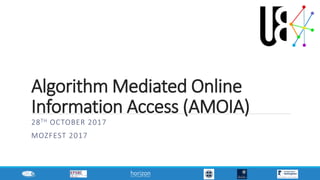
Algorithmically Mediated Online Inforamtion Access at MozFest17
- 1. Algorithm Mediated Online Information Access (AMOIA) 28TH OCTOBER 2017 MOZFEST 2017
- 2. UnBias: Emancipating Users Against Algorithmic Biases for a Trusted Digital Economy User experience of algorithm driven internet platforms and the processes of algorithm design
- 3. UnBias: Emancipating Users Against Algorithmic Biases for a Trusted Digital Economy Mission: Develop co-designed recommendations for design, regulation and education to mitigate unjustified bias in algorithmic systems. Aim: A ‘fairness toolkit’ consisting of three co-designed tools ◦ a consciousness raising tool for young internet users to help them understand online environments; ◦ an empowerment tool to help users navigate through online environments; ◦ an empathy tool for online providers and other stakeholders to help them understand the concerns and rights of internet users.
- 4. Limited resources assignment problem: Choose your favourite character to play Each character can be played by only one player
- 6. The algorithm decision principles A1: minimise total disparity while guaranteeing at least 70% of maximum overall satisfaction A2: maximise the minimum individual satisfaction while guaranteeing at least 70% of maximum overall satisfaction A3: maximise overall satisfaction A4: maximise the minimum individual satisfaction A5: minimise total disparity
- 7. Here is one we did earlier with CS students A1: minimise total distance while guaranteeing at least 70% of maximum possible utility A2: maximise the minimum individual student utility while guaranteeing at least 70% of maximum possible total utility A3: maximise total utility A4: maximise the minimum individual student utility A5: minimise total distance Most preferred Least preferred
- 8. Case Study 1: The role of recommender algorithms in online hoaxes and fake news
- 9. Questions to consider 1. How easy is it for a) individual users and b) groups of users to influence the order to responses in a web-search? 2. How could search engines weight their search results towards more authoritative results ahead of more popular ones? Should they? 3. To what extent should web search platforms manually manipulate their own algorithms and in what instances? NB Google has made a number of adjustments re anti-Semitism etc. and places a suicide help line at the top of searches about how to kill oneself. 4. To what extent should public opinion influence the ways in which platforms design and adjust their autocomplete and search algorithms? 5. What other features should and should not have a role in influencing the design of autocomplete and search algorithms?
- 10. Case Study 2: Unintended algorithmic discrimination online – towards detection and prevention Personalization can be very helpful However there are concerns: 1. The creation of online echo chambers or filter bubbles. 2. The results of personalisation algorithms may be inaccurate and even discriminatory. 3. Personalisation algorithms function to collate and act on information collected about the online user. 4. Algorithms typically lack transparency.
- 11. Questions to consider: 1. What is your response to this comment from Mark Zuckerberg to explain the value of personalisation on the platform? “A squirrel dying in front of your house may be more relevant to your interests right now than people dying in Africa” 2. What (legal or ethical) responsibilities do internet platforms have to ensure their personalisation algorithms are 1) not inaccurate or discriminatory and 2) transparent? 3. To what extent should users be able to determine how much or how little personal data internet platforms collect about us? 4. To what extent would algorithmic transparency help to address concerns raised about the negative impacts of personalisation algorithms? 5. Is there any point to algorithmic transparency? What might be some useful alternatives?
